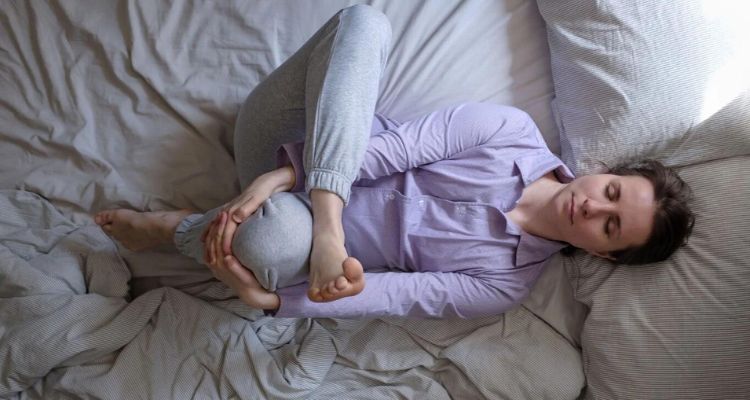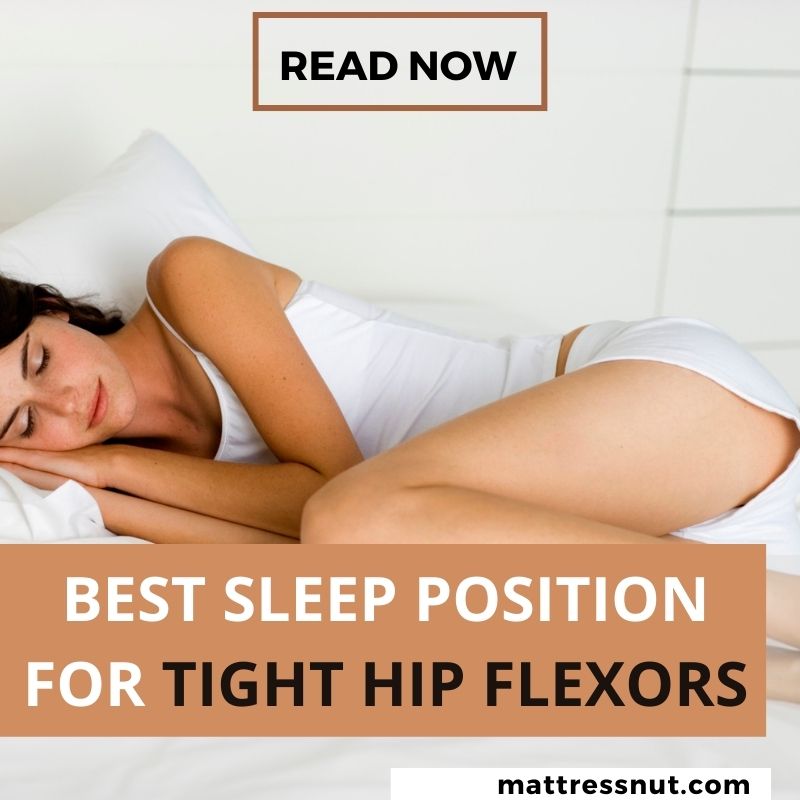The human hip is a ball and socket joint that allows you to walk, run, climb, etc. It is the fundamental element that helps provide motion. However, this range of motion can sometimes lead to tightness in the hip flexors. And sleeping with a tight hip flexor is a frustrating experience. We have tried a few quick fixes to help you with the pain.
Below are some of the best sleep positions for tight hip flexors.
Flat on Your Back
The best position to stretch and release tightness in the hip flexors is to lie flat on your back. This position can help stretch out the hip flexors and alleviate some tension. It works as a great relief from chronic or acute back pain. The pressure onto the spine is released, and you feel relieved. Just use a pillow under your knees to keep your back aligned.

Pillow Between Your Knees
A few different sleeping positions can help alleviate pain in the hip flexor region. But it is always best to place a pillow between your knees. This helps to take some of the pressure off the hip flexor muscles and can help to reduce pain and stiffness. Another good position is to sleep on your side with a pillow under your top leg.
Side Sleeping With a Pillow
Side sleeping with a pillow between your legs is a good position for tight hip flexors. This position is good for your hips and pelvis because it keeps them aligned and removes pressure. It also lets your muscles and joints relax, which can help reduce pain and stiffness. If you have trouble sleeping on your side, use a body pillow or place a pillow under your knees to help keep your hips and pelvis aligned.
Fetal Position
The fetal position is often considered the best for tight hip flexors. This is because the position allows the hips to be flexed and the knees to be bent. This eventually takes the pressure off of the hip flexors. Additionally, the fetal position can help to stretch out the hip flexors.
Lie on your back, bend your knees inwards, and lay your feet flat. Hold onto your knees towards your chest in a hugging position. This position can also be done with a pillow under the knees for support.
Elevated Hips
High hips are the best position for tight hip flexors. This position helps to stretch and lengthen the hip flexors, which can become tight and shortened from sitting for long periods. Sleeping with your hips elevated stretches the muscles and soothes the pain.
You can also work out to help relax and perform hip elevation as a routine. To do this stretch:
- Lie on your back with your hips and knees bent and your feet flat.
- Place a pillow or blanket under your right hip and raise your left leg. You should feel a gentle stretch through your right hip and leg.
- Hold this position for 30 seconds to 1 minute, and then switch sides.
More Ways to Manage Hip Pain
The Right Mattress to Sleep On
It’s the most crucial factor because it may be the most significant reason. Back and hip pain and stiffness can result from sleeping on the wrong type of mattress. You need to consider your sleeping position and then decide on the firmness of your mattress.
Sleeping on something too soft or too firm can result in chronic pains and uneasiness. Invest well in a good mattress because it eventually makes or breaks your body while you sleep.
A Balanced Routine
Following a specific sleeping and work routine is vital for a healthy body. Your rest and activities should be balanced so the muscles are neither too strained not too relaxed. They should stretch and relax equally to avoid under or over-stretching the hip muscles.
Exercising and Stretching
Exercising during the day and stretching before bed may have more benefits than you can imagine. Stretching or performing yoga before sleep is a great hip pain reliever.
The Right Diet
Correct body weight and a nutritious diet are key to managing hip pain. The lesser you weigh, the less pressure is exerted on your joints. If you work long sitting hours, try to control your weight with proper food and exercise.
Conclusion
Finding the best sleep position for tight hip flexors is essential to avoid hip pain. Uncomfortable sleeping positions and wrong mattress firmness lead to tight hip flexors. Other than changing your day-to-day routine, try to work out a sleeping position to relieve the pain.
Best Sleep Position For Tight Hip Flexors FAQs
How Can I Relax My Hip Flexors In Bed?
You can do a few things to relax your hip flexors in bed. One is to prop up your legs on a pillow or two to elevate them. This will take the pressure off your hips and allow them to relax.
Another is to do some gentle stretching exercises before you go to bed. This will help to loosen up your hip flexors and make them more relaxed. Finally, get up and move around every few hours to keep your hips from getting too stiff.
How Can I Loosen My Hip Flexors Fast?
You can do a few things to loosen your hip flexors fast. First, try some simple stretches and exercises that target the hip flexors.
You can try massaging the back and lower area. It can be done either professionally or using a, use a foam roller. You can go for heat or cold therapy if you feel tight.
Finally, you can see a doctor or physical therapist for help if you still have trouble.
Does Sleeping On Your Side Cause Hip Tightness?
The answer to this question varies as much as everybody’s body does. However, some people find that sleeping on their side can cause hip tightness.
This is likely due to how your body positions when you sleep on your side, which can pressure your hips. It matters if you sleep on a too-firm mattress. The curves of your body experience extreme pressure, which is not released unless the mattress conforms.
If you find that sleeping on your side causes hip tightness, try sleeping on your back or stomach instead. Alternatively, you can change the firmness of your mattress, going for a plusher one, if you want to sleep on your side.

